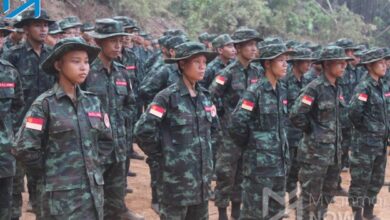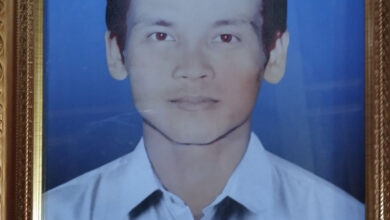
Thousands have been rendered homeless and about 20 children have gone missing after a fire broke out on March 5 at a refugee camp on the Bangladesh-Myanmar border.
The fire started on the afternoon of March 5 in Ward 11 of the Balukhali refugee camp, located in Ukhiya Upazila, Cox’s Bazar District, Bangladesh. It lasted for two hours and resulted in injuries to 50 residents of the camp, according to local sources.
The Balukhali refugee camp was originally made up of around 8,000 shelters housing refugees from northern Rakhine State.
Some of the injured persons are currently in critical condition and undergoing treatment by rescue teams, according to a resident of the camp who asked to remain anonymous.
He added that only around 80 of some 100 children who went missing during the fire had been found, and that the families who lost their homes in the fire were now facing food insecurity.
“Some of the families have teenage daughters, so these living conditions, including the conditions of bathrooms and toilets, are extremely difficult for them. We haven’t received government aid at all but we have received some help with food from international organisations. It appears that the government is granting permission to INGOs to help us,” the man said.
A Rohingya teacher from northern Maungdaw Township, now living in Bangladesh, also spoke with Myanmar Now about the aftermath of the fire.
“There’s an NGO here named IOM. They gave us some bamboo and sheets as well as rice, oil, salt, and chili powder, as they usually do. Some civilian organisations donated as well,” he said, referring to the International Organisation for Migration, a UN agency.
Camp residents told Myanmar Now that the fire had destroyed over 2,000 dwellings, a hospital, a school, and religious buildings. The occupants of the destroyed shelters now had to stay with relatives or in nearby mosques and schools, the residents said.
The Bangladesh office of the United Nations High Commissioner for Refugees (UNHCR) initially estimated that the fire destroyed around 2,000 shelters, rendering some 12,000 people homeless. In an updated March 7 report, the UN agency estimated even greater damage, totaling about 3,000 shelters destroyed, resulting in some 16,000 injuries in the camp.

The cause of the fire
Residents of the camp have offered various theories as to how the fire started.
According to one resident, some guessed that the fire started during a clash between members of the Arakan Rohingya Salvation Army (ARSA) and the Rohingya Solidarity Organization (RSO) who had infiltrated the camp.
“There is always conflict in this camp. People are now saying that someone started the fire on purpose but I didn’t see it with my own eyes, so I have no comment on that. The terrorist ARSA forces are living among us in the camp. RSO doesn’t want ARSA either,” the Rohingya man said.
The teacher from Maungdaw also pleaded ignorance.
“Some are saying it was an accident while some say someone started it on purpose. It’s very hard to say as no one actually saw what happened. Even if someone actually saw what happened, I think disclosing the truth to anyone would put one’s life in danger,” he said.

Murders in the camps
A recent series of violent incidents may have helped give rise to the speculation among camp residents that the fire was connected to hostilities between locally active armed groups.
On February 16, Adu Rohim, a 37-year-old supervisor of the Balukhali refugee camp, was shot dead.
A 35-year-old man living in Block C/5, on the western side of Ward 2 of the Balukhali camp, was killed by four unidentified gunmen on February 5, according to the residents of the camp.
Residents claim that ARSA and RSO always assign blame to one another after a murder occurs.
There were more than 200 fires at refugee camps in Bangladesh between January 2021 and December 2022, of which 60 were due to arson, according to a report released by the Bangladeshi Ministry of Defence in February.
A clash broke out on January 17 between the ARSA and RSO in a camp populated by some 2,000 refugees on the Bangladesh-Myanmar border. The fire that started during the fighting reportedly burned for two full days.
The teacher who had fled Maungdaw said that the frequency of the attacks made it feel as if he and other refugees had lost all security, and that they were in fear for their lives.
“Even if we knew which organisations were doing these things, it would be very hard for us to disclose it to anyone. We don’t have security over our lives here. The Bangladeshi government does give us some protection but there’s only so much they can do,” he said.
There are currently 34 Rohingya refugee camps in Bangladesh, housing around 1 million Rohingya refugees.
The mass displacement of Rohingya people began in August 2017, when Myanmar’s military began torching houses and massacring Rohingya residents of Rakhine State’s Maungdaw, Buthidaung, and Rathedaung townships.
Around 700,000 Rohingya people were ultimately displaced to Bangladesh by the armed forces’ so-called “clearance operations” in the state.
![Resistance fighters holding heavy weapons ammunition in central Myanmar. (Photo: Freedom Revolution Force [FRF])](https://myanmar-now.org/en/wp-content/uploads/sites/5/2024/04/438869056_443267851680128_1706386881626943924_n-390x220.jpeg)


